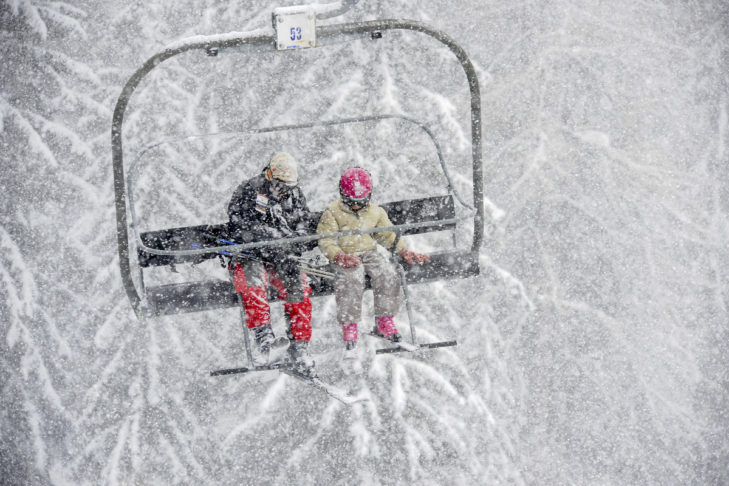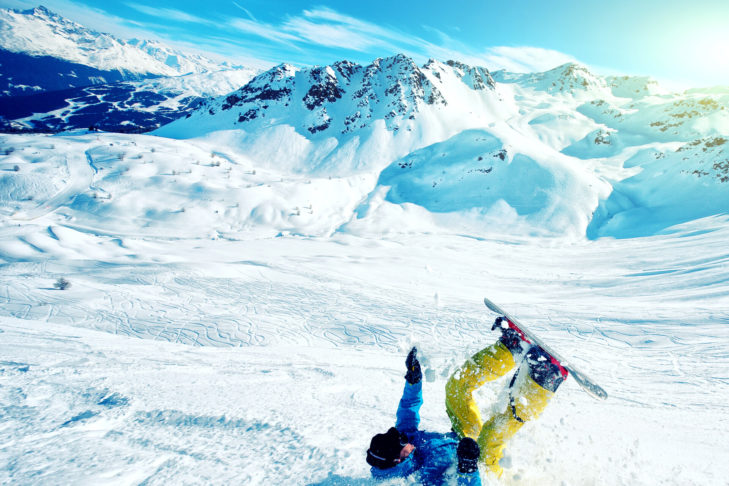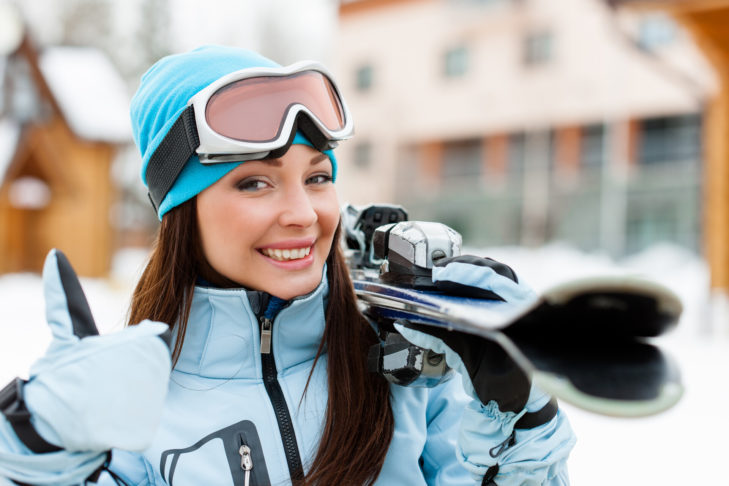They may only be a small component of your ski equipment, but they are not to be underestimated: ski gloves keep our hands warm even in the coldest of conditions – at least they should. They also offer protection in the event of falls and when carrying sharp-edged skis and snowboards. The choice of ski gloves can be overwhelming for some winter sports enthusiasts, so it makes sense to get some information before buying ski gloves. SnowTrex has put together information about what winter sports fans should look out for when choosing gloves for skiing or snowboarding in order to keep their fingers warm as well as what else ski gloves can do.
Which ski gloves fit me?
Ski gloves are available in a wide range of designs and sizes, so there is guaranteed to be the right ski glove for everyone. Firstly, winter sports enthusiasts should realise what type of ski gloves they prefer: mittens, finger gloves, gloves for the snow park or ski gloves for deep powder. Once this has been clarified, it’s time to decide on the right size. Men generally have larger hands than women, so it usually makes sense for men to choose ski gloves for men and women to consider models for women.
In the case of finger gloves, i.e. gloves in which each finger is individually enclosed by the glove, particular attention should be paid to the pre-shaped fingers in the glove. Only precisely pre-shaped fingers that fit snugly, but not too tightly, around your own fingers will give the glove or the hand in it the necessary sensitivity. You should therefore ensure a perfect fit and select gloves for men and women accordingly. Gloves that are too tight not only reduce dexterity, but also the blood flow and therefore the ability to produce heat.
Mittens should also not be too tight or too short. It should be possible to fully stretch the fingers without any problems and to move the fingers and thumbs well so that the blood circulation is not disturbed and the hands stay nice and warm.
Specialist retail vs. the Internet
When buying ski gloves, it generally makes sense to try them on directly. It is therefore advisable to look for a specialist retailer with a large selection in order to find the glove with the perfect fit. Of course, winter sports enthusiasts can also order them online, but there is a risk that they will not find the right glove or that the models ordered will not fit perfectly. Under no circumstances should you make any compromises here, as this will inevitably lead to cold fingers on the piste. If snow lovers decide to order ski gloves online, they should measure their hands and fingers with a tape measure beforehand and check the product descriptions carefully. This increases the chances of finding the right ski gloves. Instructions on how to measure your hands correctly can be found on the Internet.
Warm hands on the slopes
Nobody really wants to have cold hands during winter sports and to avoid this, winter sports enthusiasts need gloves whose most important function is of course to keep their hands properly warm. This is largely dependent on the insulation and lining of the gloves.
Strictly speaking, gloves do not actually warm the hands, but act as insulation so that they do not lose temperature. The insulation of the gloves is crucial for the continuous generation and maintenance of hand warmth. The gloves should be both waterproof and breathable so that the hands do not sweat because moisture has the opposite effect, i.e. the hands freeze. Ideally, the insulation should be made of natural down, but usually synthetic materials are used. Manufacturers such as Hestra, Ziener, Reusch, Leki & Co. often have their own special ‘secret formulas’ and have these compositions protected by name. In order to produce gloves that are warm but not too bulky, the manufacturers often use more insulation on the back of the glove than on the palm.
When trying on gloves, you should pay attention to the thickness of the lining: The hand must still be able to grip a ski pole well. Some gloves also have removable liners, like a glove inside a ski glove. This is practical in two ways: firstly, you can wash them out quickly. Secondly, you can vary the thickness of the gloves depending on the weather and temperature.
Wet hands = cold hands
It is basically unavoidable that ski and snowboard gloves come into contact with snow from time to time. This happens not only in the event of a fall, but also when carrying the boards or snowfall on the piste. To prevent your hands from getting wet and consequently cold, ski gloves must be waterproof or at least water-repellent. Fleece or fabric gloves are therefore not suitable for alpine winter sports. Some manufacturers specify the so-called ‘water column’ for gloves, which provides information about the water permeability. In Germany, fabrics are considered waterproof from a water column of 1,500 mm, but in Switzerland only from 4,000 mm.
Ski gloves provide protection
When you think of ski gloves, you think first and foremost of their warming properties. At the same time, however, they also fulfil a protective function. Falls on icy slopes can lead to abrasions at sufficient speed, which gloves protect against. The soft material also cushions the impact and prevents injuries to your own or other people’s equipment in the event of a collision.
Ski gloves also offer protection off the piste. In the gondola or on the ski bus, you are constantly picking up your skis or snowboard. Without gloves, you can hurt or even injure yourself on the sharp edges. Gloves should therefore be reinforced with extra material that is more cut-resistant than the usual fabric, especially on the palms and fingertips.
Gloves with wrist protection
When you fall, you intuitively try to catch yourself with your hands, which means that your hands and wrists are often affected by injuries. This is why gloves with integrated wrist protection are particularly popular among beginners and park and pipe riders. In addition to the protective functions offered by a conventional glove, the wrist of winter sports enthusiasts is additionally protected by a plate or cuff integrated into the glove. For winter sports enthusiasts who already have suitable gloves, there are also separate protectors for the hands that can be worn under gloves. Incidentally, the wrist is affected in no less than 30% of all snowboarding injuries. So it’s no wonder that most boarders don’t want to do without wrist protection in their gloves.
Mittens or gloves
If you suffer particularly badly from cold hands, you should buy mittens for skiing or snowboarding. Mittens are generally warmer than finger gloves because the fingers warm each other inside the glove. It should be borne in mind that mittens are not quite as flexible as finger gloves when it comes to gripping and fine motor skills.
Winter sports enthusiasts who find it difficult to choose between mittens and finger gloves can consider three-finger gloves, also known as split-finger gloves. With these gloves, the thumb and index finger are each insulated separately, while the middle, ring and little fingers are enclosed together. Of course, fine motor skills and dexterity are not as good as with finger gloves, but the index finger can be moved separately, making them much better than mittens. Split-finger gloves are particularly popular with freestylers and freeriders who want warm hands on the one hand and enough flexibility to grip their skis or snowboard on the other.
Heated ski gloves
If you know that you get cold quickly, you should opt for heated ski gloves. These are fitted with a rechargeable battery that heats wires sewn into the glove so that the frostbitten winter sports enthusiasts always have warm fingers. The powerful batteries usually last between four and seven hours and can be recharged in the evening with a special charger or via USB. Of course, heated ski gloves come at a price, but for winter sports enthusiasts who constantly suffer from cold fingers, the price is definitely worth it. Incidentally, in addition to heated ski gloves, there are also heated ski and snowboard boots and insoles to keep snow lovers’ feet warm.
Ski gloves for small children
The right gloves are incredibly important, especially for the youngest snow lovers. Children don’t want cold hands and parents don’t want whining children on the piste. As small children fall more often, their hands also end up in the snow more often. It is therefore important that the gloves are waterproof and not just water-repellent. In addition, mittens are recommended for the professionals of tomorrow, as they keep little hands warmer than finger gloves, as the fingers in the mittens lie against each other and thus keep each other warm. The right size of ski gloves is very important for children, as their hands are still growing. Parents should make sure that children are never on the piste with gloves that are too small, as this can be painful, disrupt blood circulation and lead to cold fingers.
To save children and parents trouble, it is a good idea to tie the gloves to the wrist or jacket of the little rascals. This way, the gloves can be taken off without falling into the snow or having to search for them. This can save time and hassle with all the equipment that has to be carried around during winter sports.
Smartphone ski gloves
The smartphone has also become indispensable on the piste. Many winter sports enthusiasts use it to take pictures or to communicate with fellow travellers, for example to meet up for lunch. Unfortunately, this can sometimes be awkward, as the touchscreen cannot be operated with conventional gloves, so the gloves have to be taken off. This takes time and your hands get cold. Fortunately, there are more and more ski gloves that are coated with a special material on the fingertips that can be used to operate smartphones. This means you can type, post and google without your fingers getting cold.
Ski gloves for freeriders
The Velcro fastener on the glove is essential for freeriding with warm and dry hands: this type of elasticated cuff not only prevents the heat from escaping from your hands, but also prevents snow from getting into the gloves in the event of a fall, for example. Nothing is more unpleasant than a cold, wet inner glove lining.
The cuff length is also of crucial importance for freeride gloves. When it comes to the cuff length of the gloves, you basically have the choice between short and long cuffs. Short cuffs can be worn very well under the jacket sleeve so that no cold air reaches the wrists. These gloves are called ‘under gloves’ and are particularly popular with winter sports enthusiasts who spend most of their time on the piste. Long cuffs are worn over the sleeves of a jacket and can usually be fastened separately. These gloves are called ‘over gloves’. Over gloves are particularly popular with freeriders as the cuff, which is fastened over the jacket, ensures that no snow gets into the gloves or sleeves when powder skiing. Ideally, the jacket sleeves should also have thumb loops to ensure a perfect fit between glove and jacket.
Pipe gloves for freestylers
Pipe gloves are thin finger gloves with little or no insulation. They are particularly suitable for freestylers who practise their tricks in the snow park and need as much freedom of movement and flexibility in their hands as possible. This flexibility is essential for grabs, i.e. gripping the skis or snowboard – especially for skiers who also have to hold the ski poles when grabbing. Pipe gloves are particularly recommended for skiers and snowboarders when it is very warm on the mountain, but you still want to protect your hands – and should!
Ski gloves with certain extras
In addition to the basic functions, some ski gloves come with little extras that make your day on the piste even more comfortable and round off the perfect ski glove.
Glasses/nose wiper
Many gloves have a suede-like insert on the thumb or index finger. This can be used to wipe snow off ski goggles – or to quickly dry a runny nose. However, a handkerchief is particularly suitable for the latter.
Pockets on the glove
Some gloves have small pockets on the top. They are practical for putting in your ski pass or a small hand warmer. If you don’t pack anything in them, you can still leave them open. This promotes air circulation inside the glove.
Clip fastener
Small clips on both gloves make it possible to clip the gloves together after a day’s skiing. This prevents you from only having one glove on the piste at any one time. So you always have two with you – or none.
FAQ
Which gloves keep you warm?
Mittens generally keep you warmer than gloves. This is because the fingers in mittens touch each other and therefore keep warm. Whether gloves keep you warm or not also depends largely on whether the gloves are the right size. If the gloves are too big, there is too much air in the glove, which does not warm up sufficiently. If the gloves are too small, the fingers can no longer be sufficiently supplied with blood and cool down quickly.
Which gloves are suitable for skiing?
Gloves that are to be used for skiing or snowboarding must be waterproof and keep your hands warm even at very low temperatures. Basically, the choice of the right glove depends on the area of use. Mittens are generally slightly warmer than finger gloves. However, winter sports enthusiasts have a little more flexibility and fine motor skills in finger gloves, as the fingers can be moved independently of each other. While mittens are particularly suitable for children and beginners, finger gloves are very popular among freestylers, for example, as they are easier to perform grabs with.
What should I look out for when buying ski gloves?
Ski gloves should be waterproof and keep you warm even at low temperatures. It is also important that the gloves fit well. Snowboarders should also consider gloves with integrated wrist protection due to the high risk of injury to the wrist.
Which ski gloves are suitable for small children?
Mittens are recommended for small children. These keep the fingers warmer than conventional gloves and guarantee absolute fun on the piste for the professionals of tomorrow.
Which ski gloves are suitable for freeriders?
Over Gloves are particularly suitable for freeriders. These are gloves with long cuffs that are fastened over the jacket sleeves. This ensures that no snow gets into the gloves or sleeves when powder skiing.
What are pipe gloves?
Pipe gloves are gloves that are particularly popular among freestylers who let off steam in the park and in the halfpipe. Pipe gloves are thin finger gloves with little insulation. Thanks to the thin material, the fingers are flexible and freestylers can grip the board or skis well when performing tricks.
What is the difference between finger gloves and mittens?
Whereas with finger gloves each finger is individually enclosed by the glove, with mittens all fingers except the thumb are enclosed together in a common interior.
Do ski gloves provide protection?
Ski gloves protect your hands when carrying sharp-edged skis. In the event of a fall, the soft material cushions the impact and prevents abrasions that can occur on icy sections of piste. Ski gloves also protect against the cold.
How do heated ski gloves work?
Heated ski gloves usually have heat plates or wires sewn into them, which are heated by a rechargeable battery. The battery can be charged with a charger or via USB.
How do smartphone ski gloves work?
The fingertips of smartphone ski gloves are covered with a special fabric in which conductive materials such as silver yarn are woven. This allows the touchscreen to receive the finger’s electrical voltage and react accordingly.
.













